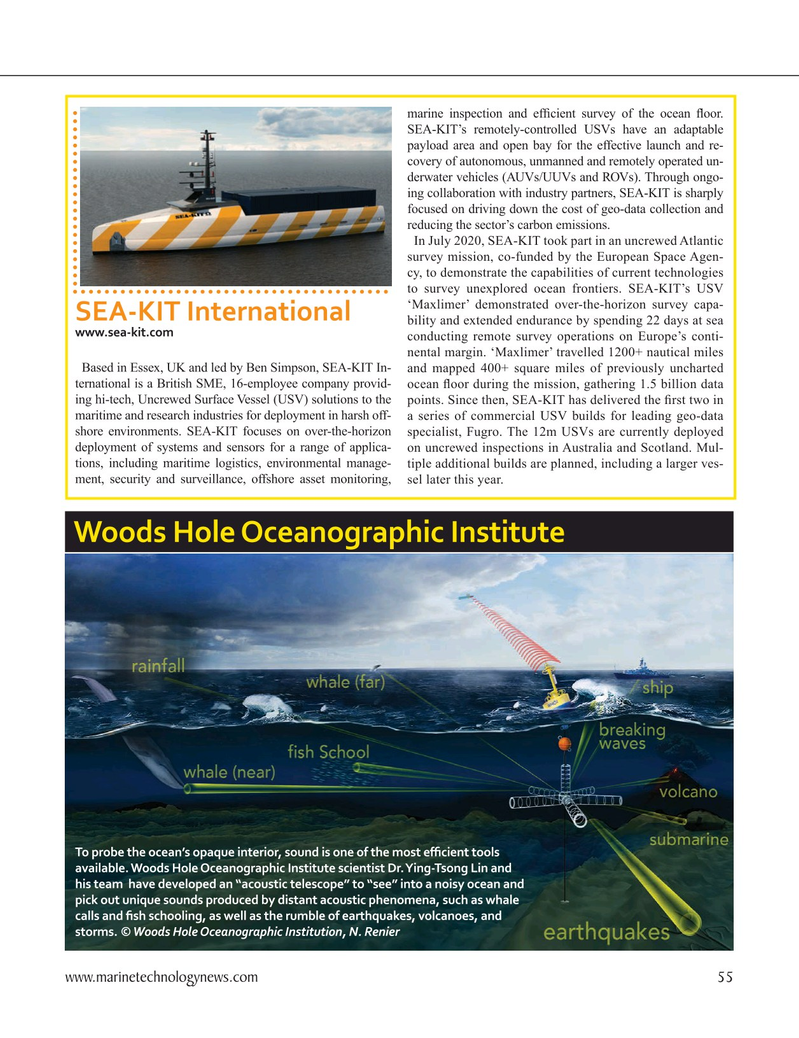
Page 55: of Marine Technology Magazine (September 2021)
MTR100: Focus on 100 Leading Companies, People and Innovations in the Subsea Space
Read this page in Pdf, Flash or Html5 edition of September 2021 Marine Technology Magazine
marine inspection and ef? cient survey of the ocean ? oor.
SEA-KIT’s remotely-controlled USVs have an adaptable payload area and open bay for the effective launch and re- covery of autonomous, unmanned and remotely operated un- derwater vehicles (AUVs/UUVs and ROVs). Through ongo- ing collaboration with industry partners, SEA-KIT is sharply focused on driving down the cost of geo-data collection and reducing the sector’s carbon emissions.
In July 2020, SEA-KIT took part in an uncrewed Atlantic survey mission, co-funded by the European Space Agen- cy, to demonstrate the capabilities of current technologies to survey unexplored ocean frontiers. SEA-KIT’s USV ‘Maxlimer’ demonstrated over-the-horizon survey capa-
SEA-KIT International bility and extended endurance by spending 22 days at sea www.sea-kit.com conducting remote survey operations on Europe’s conti- nental margin. ‘Maxlimer’ travelled 1200+ nautical miles
Based in Essex, UK and led by Ben Simpson, SEA-KIT In- and mapped 400+ square miles of previously uncharted ternational is a British SME, 16-employee company provid- ocean ? oor during the mission, gathering 1.5 billion data ing hi-tech, Uncrewed Surface Vessel (USV) solutions to the points. Since then, SEA-KIT has delivered the ? rst two in maritime and research industries for deployment in harsh off- a series of commercial USV builds for leading geo-data shore environments. SEA-KIT focuses on over-the-horizon specialist, Fugro. The 12m USVs are currently deployed deployment of systems and sensors for a range of applica- on uncrewed inspections in Australia and Scotland. Mul- tions, including maritime logistics, environmental manage- tiple additional builds are planned, including a larger ves- ment, security and surveillance, offshore asset monitoring, sel later this year.
Woods Hole Oceanographic Institute
To probe the ocean’s opaque interior, sound is one of the most e? cient tools available. Woods Hole Oceanographic Institute scientist Dr. Ying-Tsong Lin and his team have developed an “acoustic telescope” to “see” into a noisy ocean and pick out unique sounds produced by distant acoustic phenomena, such as whale calls and ? sh schooling, as well as the rumble of earthquakes, volcanoes, and storms. © Woods Hole Oceanographic Institution, N. Renier www.marinetechnologynews.com 55
MTR #7 (50-65).indd 55 9/21/2021 11:31:37 AM

 54
54

 56
56
